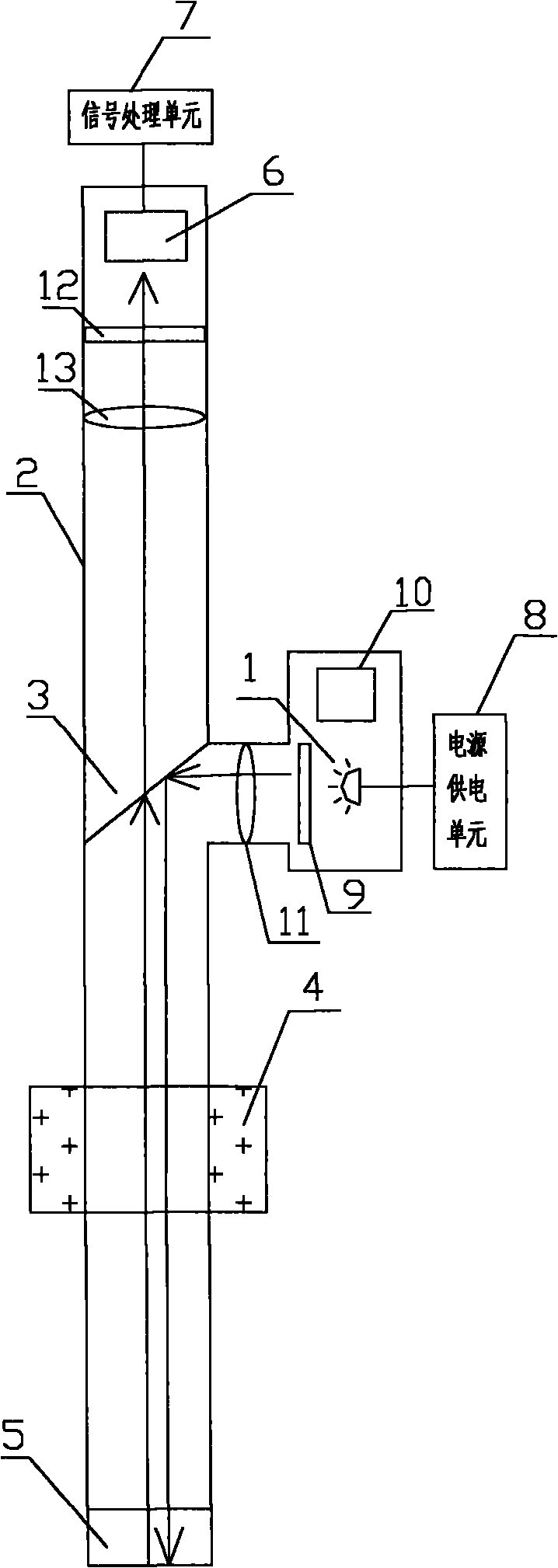Device for testing residence time distribution (RTD) of material
A residence time and distribution testing technology, applied in measuring devices, material excitation analysis, material analysis through optical means, etc., can solve problems such as melting of adhesives, inconvenient use, fiber detachment, etc., to reduce coupling loss and cost, Compact optical path layout, convenient isolation effect
- Summary
- Abstract
- Description
- Claims
- Application Information
AI Technical Summary
Problems solved by technology
Method used
Image
Examples
Embodiment 1
[0022] Such as figure 1 As shown, the material residence time distribution test device includes an excitation light source 1, a light tube 2, a half mirror 3, a heat insulation layer 4, an optical window 5, a fluorescence detector 6, a signal processing unit 7, a power supply unit 8. Excitation light source filter 9, light source lens 11, fluorescent filter 12 and fluorescent lens 13. In this embodiment, the excitation light source 1 is a light emitting diode, and the light tube 2 is a stainless steel cylinder that is opaque and resistant to high temperatures. The power supply unit 8 is a constant current power supply, which drives the light-emitting diodes so that the light-emitting diodes emit a stable excitation beam. A light source detector 10 is provided at the excitation light source 1 to monitor the stability of the excitation light source 1 and compensate the measurement result according to the fluctuation of the excitation light source 1. The excitation light beam pas...
Embodiment 2
[0025] Such as figure 2 As shown, the material residence time distribution test device includes an excitation light source 1, a light tube 2, a half mirror 3, a heat insulation layer 4, an optical window 5, a fluorescence detector 6, a signal processing unit 7, a power supply unit 8, The light source lens 11 and the fluorescent lens 13. In this embodiment, the excitation light source 1 is a light emitting diode, and the light tube 2 is a stainless steel cylinder that is opaque and resistant to high temperatures. The power supply unit 8 is a constant current power supply, which drives the light-emitting diodes so that the light-emitting diodes emit a stable excitation beam. The excitation light beam passes through the light tube 2, sequentially passes through the light source lens 11, the half mirror 3 and the optical window 5 to reach the material to be measured. The tracer in the tested material is excited by the excitation beam and emits a certain wavelength of fluorescence...
Embodiment 3
[0028] Such as image 3 As shown, the material residence time distribution test device includes an excitation light source 1, a light tube 2, a half mirror 3, a heat insulation layer 4, an optical window 5, a fluorescence detector 6, a signal processing unit 7, a power supply unit 8. Excitation light source filter 9, light source lens 11, fluorescent filter 12 and fluorescent lens 13. In this embodiment, the excitation light source 1 is a light emitting diode, and the light tube 2 is a stainless steel cylinder that is opaque and resistant to high temperatures. The power supply unit 8 is a constant current power supply, which drives the light-emitting diodes so that the light-emitting diodes emit a stable excitation beam. A light source detector 10 is provided at the excitation light source 1 to monitor the stability of the excitation light source 1 and compensate the measurement result according to the fluctuation of the excitation light source 1. The excitation light beam pa...
PUM
 Login to View More
Login to View More Abstract
Description
Claims
Application Information
 Login to View More
Login to View More - R&D
- Intellectual Property
- Life Sciences
- Materials
- Tech Scout
- Unparalleled Data Quality
- Higher Quality Content
- 60% Fewer Hallucinations
Browse by: Latest US Patents, China's latest patents, Technical Efficacy Thesaurus, Application Domain, Technology Topic, Popular Technical Reports.
© 2025 PatSnap. All rights reserved.Legal|Privacy policy|Modern Slavery Act Transparency Statement|Sitemap|About US| Contact US: help@patsnap.com



